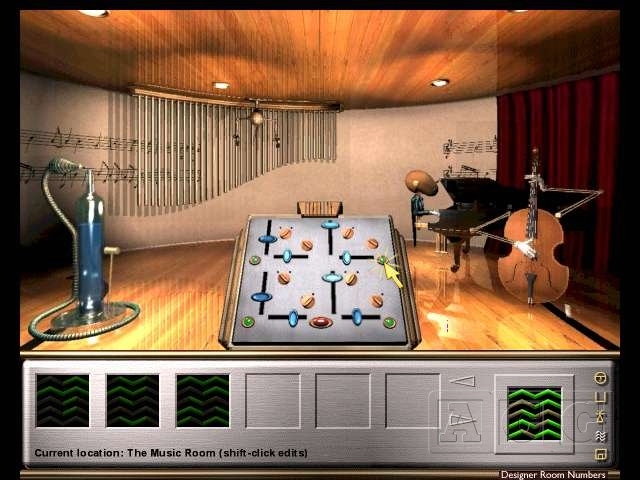
Starship Titanic Music Room
The music is nice, but does get a bit repetitive. A room control panel, a panel with saved room markers and a real world panel (save, load, settings and quit). 'Starship Titanic' comes on.
.The latest CD-ROM drives clip along at 32x speeds, but does it matter much if the content is a wheeze? These days, the average adventure disc is either another Myst imitation (eerie, unpeopled environment strewn with buried brainteasers) or an ”interactive movie” (noirish mystery rife with tremulous acting and puzzles, puzzles, puzzles). Just when you’d think that talented CD-ROM producers would all be designing websites, however, along come two deeply sophisticated new titles. While one makes the most of existing standards, the other launches interactivity into the 21st century.
Fans of the convention-warping book series The Hitchhiker’s Guide to the Galaxy shouldn’t be too surprised to learn that it’s author Douglas Adams, the John Cleese of sci-fi novelists, who dreamt up the story line and dialogue for the marvelously playful, three-disc Starship Titanic, in which the universe’s most luxurious intergalactic cruise ship crashes into your living room, luring you aboard to solve whimsical technical difficulties and — the challenge! — wangle free upgrades from steerage to first class. Adams is also responsible for introducing a major technological and structural breakthrough to adventure gaming: the ability to talk to computer characters. Thanks to SpookiTalk, Titanic‘s ingenious language analyzer, the animated, all-robot crew is programmed with 30,000-word vocabularies (ranging from Spice Girls to pluvian warthog) and 16 hours of recorded dialogue with which you engage via your keyboard. In fact, the bots’ wacky loquacity helps prevent the exquisite, futuristic Art Deco ambiance (created by the Oscar-winning designers of 1995’s period farce Restoration) from feeling too precious. From impudent Deskbot Marsinta to blithering Liftbots, the moody automatons emit Mad Hatter-style natterings if confused and snippy comebacks if miffed. Gameplay can thus depend on, of all things, interpersonal skills: Ask the surfer dude Bellbot nicely and he’ll offer hints.
Act rude and he’ll trade insults and complain about his creator, Adams: ”That guy has a lot to answer for around here.” Like imbuing these characters with witty repartee and uncanny sentience. By comparison, the plot’s the surprise star of Black Dahlia: It’ll take you a jaw-dropping, scarily time-sucking eight discs to crack a compelling 1940s-era string of serial killings (including the real-life murder of would-be Hollywood starlet Elizabeth Short) with ties to a Nazi occult conspiracy. In the live-action person of rookie investigator Jim Pearson (played crisply by newcomer Darren Eliker), you’ll scour creepy French catacombs, visit an institutionalized Dennis Hopper, and, thanks to Teri Garr as a goofy clairvoyant, enter the metaphysical beyond. Imagine formulaic film noir spiked with goodly doses of Raiders of the Lost Ark and dastardly puzzles like a cryptogram based on Germanic runes.
Where Black Dahlia falls short is in its dorky (albeit standard) interactive technology: You choose between two, maybe three actions from an awkwardly written predetermined list that has little bearing on the plot’s essentially linear progression. At heart, Black Dahlia is an extremely long movie riddled with puzzle-solving intermissions — a nonintuitive experience, to be sure.How freeing it feels, on the other hand, to ”converse” with a whole cast of deranged, sass-talking robots. So maybe they’re not Leonardo DiCaprio — this Titanic seems equally destined to leave the competition in its wake.
It seemed like a normal day. Sit back at your computer, put in a new CD-ROM and relax. Unfortunately the galaxy had other plans. Without warning, a loud crash introduces you to the Starship Titanic: The Ship That Cannot Possibly Go Wrong.
The champions ballad ign. The Champions’ Ballad isn’t the extra dose of story for The Legend of Zelda: Breath of the Wild that many fans were expecting, but it would be churlish to turn down another chunk of hours with one of. Champions' Ballad Walkthrough - Keive Tala Shrine. Welcome to IGN's Guide to the Legend of Zelda: Breath of the Wild's DLC Walkthrough for the Champions' Ballad. In Part 16, Link heads to begin the first trial of Champion Urbosa's Song, Keive Tala Shrine - Big or Small. EX The Champions' Ballad. Last Edited: December 16, 2017 at 8:32 PM. The EX The Champions' Ballad is one of DLC Main Quests in The Legend of Zelda: Breath of the Wild. It is located at the Shrine of Resurrection at the Great Plateau. The Legend of Zelda: Breath of the Wild DLC Pack 2 - The Champions' Ballad is the second of two DLC packs for the game. The DLC was released the night of December 7th, 2017 - revealed during The Game Awards. The Champions' Ballad, unlike the first DLC Pack - contains new story elements and dungeons, in addition to new costumes and weapons.
As the galaxy's most most prestigious, most impressive, largest and therefore most expensive interstellar liner, the Starship Titanic should be the flying treasure of the universe. Unfortunately something has, quite obviously gone wrong, or at least gone unexpectedly. The ship's main computer, Titania, has been sabotaged and gone insane. As a result, all the artificial personalities that manage the ship are also affected.
 This period slowly came to a close when Eric started his series on Five Nights at Freddy's and Geometry Dash, which became a surprise hit. He later picked up Mario Maker and it attracted many people, to the point where his videos were split nearly 50/50 until he separated his channels to appease the YouTube algorithm.Geometry DashGeometry Dash is Eric's most played game, which is also the game he is famous for. Eric would go on to make lets plays for its sequels Corpse Party: Book of Shadows and Corpse Party: Blood Drive.
This period slowly came to a close when Eric started his series on Five Nights at Freddy's and Geometry Dash, which became a surprise hit. He later picked up Mario Maker and it attracted many people, to the point where his videos were split nearly 50/50 until he separated his channels to appease the YouTube algorithm.Geometry DashGeometry Dash is Eric's most played game, which is also the game he is famous for. Eric would go on to make lets plays for its sequels Corpse Party: Book of Shadows and Corpse Party: Blood Drive.
You'll need to deal with a DeskBot, a BellBot, a BarBot not to mention a sarcastic parrot, a proud elevator and a stupid bomb. Without time or consideration to any other options, you find yourself quickly shanghaied aboard the Titanic, given an cheap, economy-sized room and put in charge of fixing the puzzling situation aboard the ship.
Starship Titanic is a 1st-person adventure game, described by some as a fusion of Myst if it had been conceived by Douglas Adams (author of Hitchiker's Guide to the Galaxy and creative force behind this game). With a basic set of navigational controls, the player must explore the starship's many rooms, obtaining and manipulating objects and conversing with many different characters in an effort to get better lodgings and set things right along the way. Conversation with these characters is done trough a parser system that recognizes key words that the player must input. At times, you are able to adjust dials which control various attributes of a robot character's personality and general usefulness.